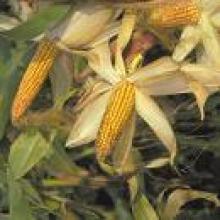
Maize plants edited using the CRISPR/Cas9 system resulting in a single base pair mutation in either the ALT gene (that plays a role in the repair of DNA damage) or the NGAL2 gene (a transcription factor that has been shown to negatively affect the expression of the PLA1 gene coding for a cytochrome P450 mono-oxygenase enzyme).
The field trial is surrounded by a 1.50 m high wired fence to prevent accidental trespassing and accidental removal or spread of GM material.
The risk of spread of the modified properties to the environment is mitigated by performing the trial on an isolated location more than 1 km away from any cultivated maize fields and by in almost all cases by removing the tassel, or in exceptional cases hulling the tassel, thus preventing the spread of modified pollen to non-modified maize plants in the surroundings. The formed modified seeds are well retained in the cobs and these cobs will be very carefully hand harvested, thus preventing any spread of seeds to the environment. In case some seeds would be lost during the harvest, they are not expected to result in the establishment of the maize outside the field.
Authorized
Information for the public
-
Public information presented according to the provisions of Directive 2001/18/EC
-
-
Information related to the decision procedure
-
10/09/2018 - Informatie voor het publiek over een veldproef (B/BE/18/V8) met genetisch gewijzigde maïs via de mutagenesetechniek CRISPR/CAS9
-
10/09/2018 - Information du public sur un essai en champ (B/BE/18/V8) avec du maïs génétiquement modifié via la technique de mutagénèse CRISPR Cas9
